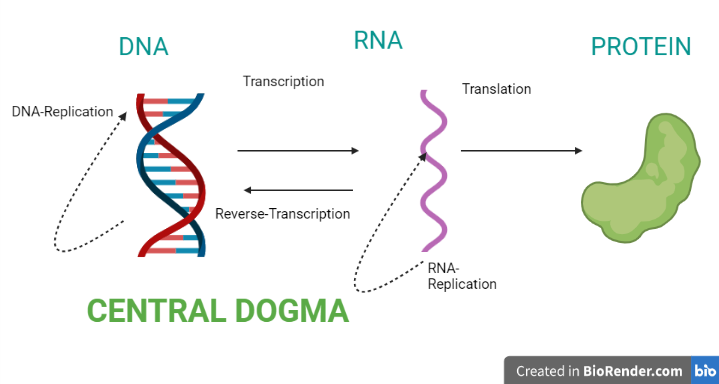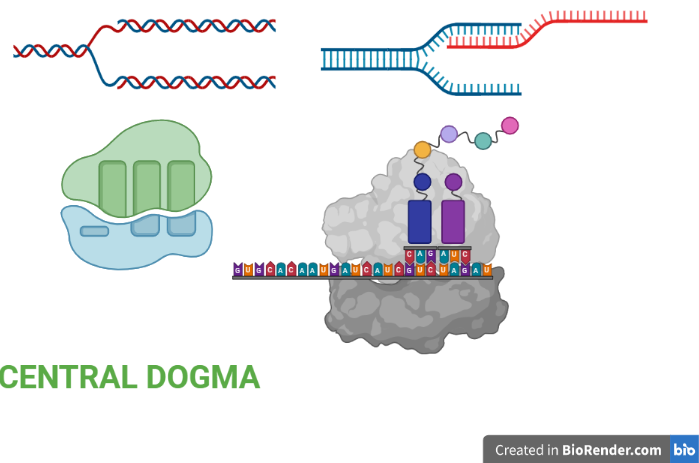Introduction:
The process of converting DNA instructions into a functional product is known as the “Central Dogma.” This is a process in which genetic information is transferred from DNA to RNA in order to produce a functioning protein. Francis Crick, who discovered the structure of DNA, first proposed it in 1958.
All living organisms are based on this process. The basic dogma is the process, which consists of four processes that are required for all life forms to exist. The information in DNA is conserved throughout replication and is passed to additional cells after cell division. Transcription converts the DNA code into mRNA. The information from the mRNA is transferred to the protein during the translation process. All biological reactions in the cell depends on this.
In addition, the reverse transcription that basically occur in the case of retrovirus such as HIV is also the process of genetic information is assembles in new DNA from RNA.

Fig: Central Dogma
DNA replication and transcription, as well as RNA translation, occur in an undivided compartment in prokaryotes (organisms lacking a nuclear membrane). All three processes have the potential to happen at the same time.
DNA replication and transcription take place in the nucleus of eukaryotes (organisms with a nuclear membrane), while proteins are generated in the cytoplasm. As a result, before RNA can be translated, it must go across the nuclear membrane. This implies that transcription and translation are separated physically. Heterogeneous nuclear RNA (hnRNA), the initial transcript, goes through substantial post-transcriptional processing to become a messenger RNA (mRNA) molecule that can pass through the nuclear membrane.

Fig: The Central Dogma in prokaryotic versus eukaryotic cells
Steps:
General transfers of biological sequential information
DNA Replication
- The ability of a cell to maintain a high level of order in an unpredictable environment is dependent on the perfect duplication of enormous amounts of genetic information carried in chemical form as DNA. Before a cell can make two genetically identical daughter cells, a process called DNA replication must take place.
- Only DNA (and, in rare cases, RNA when utilized as a reservoir of genetic information, as in the genomes of RNA viruses) are self-complementary and thus capable of replication.
Transcription
- It is a molecular event that involve the synthesis of a single-stranded RNA from a double stranded DNA template.
- The first stage in the overall process of gene expression. The process of controlling gene expression in organisms that is most often utilized. RNA polymerase is the key enzyme: it requires DNA template and ribonucleotide precursors (ATP, GTP, CTP, and UTP).
- It catalyzes the synthesis of RNA from ribonucleotide precursors using one of the two DNA strands as a template.
- The RNA transcript is identical to the coding strand in terms of sequence (with U in place of T).
Translation
- The mRNA is “read” according to the genetic code, which connects the DNA sequence to the amino acid sequence in proteins, during translation, which is the second major key in gene expression.
- In mRNA, a codon is a three-base group that defines a certain amino acid (hence, it is a triplet code). As a result, the mRNA sequence serves as a template for assembling the chain of amino acids that make up a protein in the correct order.

Fig: General transfers of biological sequential information
Special transfers of biological sequential information
RNA replication
RNA replication is the process by which RNA molecules are synthesized using an existing RNA template, typically via the activity of viral RNA-dependent RNA polymerases or reverse transcriptases, allowing for the production of multiple copies of RNA for viral replication or the conversion of RNA into DNA in retroviruses.
Reverse transcription
RNA replication is the process that occurs in the cytoplasm by which new copies of genome-length RNAs are made by the viral RNA polymerase.
The enzyme reverse transcriptase is responsible for converting a single-stranded RNA template into a double-stranded DNA molecule. Because it is the opposite of transcription, it is called reverse transcription. When a virus enters the cytoplasm of a target cell, reverse transcription begins. A nucleoprotein complex containing the viral RNA genome enter the cytoplasm.
Summary:
When a cell receives a signal that a gene must be expressed, RNA Polymerase is recruited to the region of DNA where that gene is positioned, illustrating how information is transported from DNA to RNA to protein. In a process known as transcription, it creates an RNA copy of that section of DNA. This RNA is subsequently transferred out of the cell nucleus and “translated” into a protein by ribosomes. Gene expression is the process of converting DNA (gene) into RNA (protein).
References:
- Crick, F., 1970. Central dogma of molecular biology. Nature, 227(5258), pp.561-563.
- Saw, P.E., Xu, X., Chen, J. and Song, E.W., 2021. Non-coding RNAs: the new central dogma of cancer biology. Science China Life Sciences, 64(1), pp.22-50.
- Lodish, H., Berk, A., Zipursky, S.L., Matsudaira, P., Baltimore, D. and Darnell, J., 2018. Molecular Cell Biology, Translation: Geçkil H, Özmen M, Yeşilada Ö.

